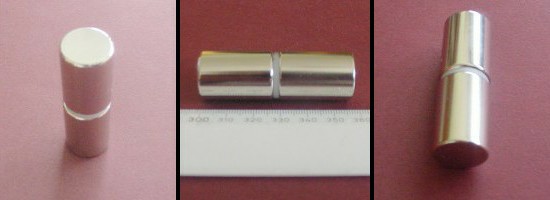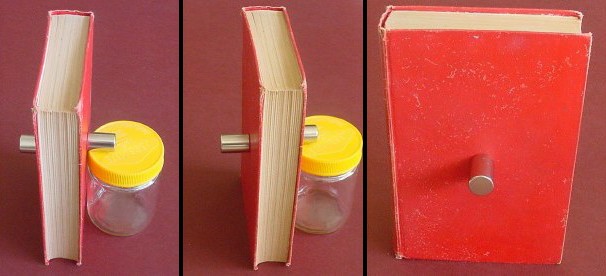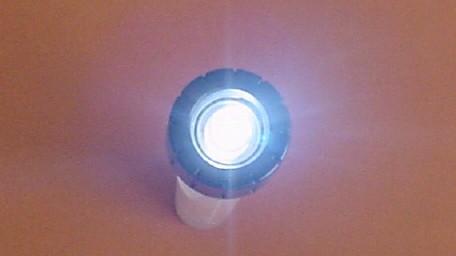
We may be living in difficult, upsetting times; but there's also reason to
hope that the world could be a better place in which to live. Over the last
two hunderd-odd years, science has advanced to the stage where we now have
the means at our disposal to make it happen.
Of course, there's always the chance that these new discoveries can be used
to make our lives an abject misery. That's always been the case: scientific
advances are regularly accompanied by abuses perpetrated by people who love
power - the wrong kind of power.
However, those of us who can envisage a better world can't allow that to
stop us trying to get it right. In this page (and other "Electrical stuff"
pages which follow), I am - without apology - attempting to present a
scenario in which well-meaning, intelligent people (which hopefully includes
you and me) can get involved to help bring this about.
OKAY? DOWN TO BUSINESS!
Although this page is the first item on my "Electrical stuff" menu, it's a
fairly late addition. Many of the pages which follow have been written
starting in early 2005; I'm starting this one on New Year's Eve - the final
day of 2005.
(Why the delay? That will become clear soon enough...)
A year or so ago, I decided it was high time that I became the owner of what
are sometimes referred to as "super magnets" (with or without the space).
These are a fairly recent development. Unlike traditional magnets, made
basically from steel, or even comparitively recent developments such as
AlNiCo magnets (made from aluminium, nickel, and cobalt - hence the name),
these very powerful magnets utilize the magnetic properties of certain
"rare-earth" (or lanthanide) metals.
One type is made from the lanthanide neodymium (chemical symbol Nd),
along with iron (Fe) and boron (B). The other well-known type is made from
another lanthanide, samarium (Sm), in combination with cobalt (these
have been around since the 1970's).
Of these two, the neodymium magnets are the stronger and more impressive.
Both types have their uses; but for the hobbyist, NdFeB (or, more simply,
NIB) magnets probably offer more "bang for the buck" - and they are now
reasonably affordable.
So, I bought myself a pair of NdFeB magnets for $15. Here they are:
They're each about 2.8cm long and 1.8cm in diameter. They came in a small
cardboard box lined with plastic foam padding, and with a plastic annular
spacer 2mm thick to keep them apart.
They're shiny because they're nickel-plated. The actual magnetic material
inside is black; I know this because I've seen a broken one. (Read on to
find out more about this...)
These little beasts are powerful - and I mean REALLY powerful!
The guy from whom I bought them told me that his boss's wife had had a
nasty encounter with a pair of these. In a silly mood, she was going to
place one on each side of her nose - but they ended up with only the septum
(the small bit of gristle separating the nostrils) between them. Apparently,
there was blood everywhere.
"OWWW!!!"
He also showed me a couple of damaged units. If they're allowed to come
together unchecked, they can slam into each other so fast that bits can
shatter off them and go flying in all directions. Each sharp little piece is
a powerful magnet in its own right. If one found its way into your eye,
you'd have something to cry about.
Just to give you some idea, here are my two with an old organic chemistry
textbook separating them. One of them is propped up on an empty Vegemite jar
(which is destined to become a Leyden jar some day
For obvious reasons, these magnets are emphatically NOT suitable for
young children to play with.
To read more about NdFeB magnets, check out
Bill Beaty's page
about them.
Here's
another page
with good information and some startling pictures of some of these
cantankerous little magnets strutting their stuff. Also, check out
this brute!
I bought my two supermagnets partly out of basic idle curiosity, and partly
because I already knew at that stage that such things may hold at least part
of the key to making devices which can tap into zero-point energy.
But let's not get ahead of ourselves. The final page accessible from my
"Electrical stuff" menu deals with ZPE in more detail; in the meantime, as a
lead-in to the main theme running through all these pages, I'd like to
discuss something more prosaic than ZPE - but only slightly so!
For Christmas 2005, I received as a present a gadget which would have been
impossible until quite recently:
It's a torch (or flashlight, if you prefer). Torches in one form or another
have been around for a long time, but this type of torch is fairly new. This
model is about 30cm (one foot) in length.
Most torches run from batteries - packages containing chemicals which react
to produce a current when their electrodes are connected (preferably to a
circuit which can do something useful). Batteries were first produced in the
late 1700's; visit
this web-page
to read a short but informative account of their development.
The problem with batteries, of course, is that they "go flat": when their
component chemicals have reacted beyond a certain point, they either have to
be recharged (if possible) or discarded. And, in my opinion, they're more
expensive than they ought to be!
The torch illustrated above doesn't have any batteries or cells of any kind.
Instead, its body contains a couple of coils of wire (centre), a rare-earth
magnet (the silvery object at the right), a small circuit-board (left, near
the switch) - and very little else!
(This torch has been manufactured so that it can't be easily opened. I
probably could open it if I tried hard enough; but I might wreck it in the
process, so I won't unless it stops working.
The body is translucent, rather than transparent - so that it's difficult to
see very much detail. However, you can see enough to get the general idea.)
So, how does it work?
With it switched off, you hold it horizontally and shake it from side to
side for a few seconds, so that the magnet slides backwards and forwards
through the coils, bumping into black rubber buffers mounted on springs at
the ends of the tube. Then, when you switch on, it lights up!
It's a direct application of electromagnetic induction, which was
discovered by the English scientist Michael Faraday (1791-1867). When a wire
moves in a magnetic field - or, equvalently, when a magnet moves relative to
some suitably-placed wire, which is happening here - a current flows in the
wire.
This current is used to charge a capacitor; this can hold a charge for a
considerable time, and thus acts somewhat like a battery. You can see the
capacitor fairly clearly in this alternative view; it's the green
cylindrical object on the circuit board:
(You'll notice that, in this view, the magnet is over to the left. There's
no special significance in that; it's just the way it was when I put the
torch down.)
The torch is switched on; you can see a white glow in the left-hand end. The
light is a modern, very bright low-current white light-emitting diode (LED).
In common with powerful rare-earth magnets, these have only been developed
quite recently; it's the combination that makes this kind of torch possible.
(Ordinary light-bulbs draw far too much current for this application; the
capacitor would be discharged very quickly - but with these fantastic LEDs,
the torch will shine brightly for several minutes before needing to be
shaken again!)
You may like to click
here
to go to a web-page with a further link to a .pdf file called induction.pdf
(near the bottom of the page), which gives a circuit diagram for a torch
similar to this but with only one coil.
(As always, be aware of the possible danger of viruses on the internet, and
take appropriate precautions.)
I suspect that each of the two coils in my torch contributes to the charging
process on one of the two shaking movements (left-right or right-left), with
some sort of simple double-diode rectification system to make it work as
required; however, as mentioned, I can't see enough detail to figure out
exactly how the circuit works. (I shouldn't think it's very complicated.)
UPDATE, 11th March 2007
That link to the .pdf file seems to have disappeared from that page.
However, there's nothing to stop you seeing what happens if you make an
adjustment to the URL in your browser's "Location" window - never know, you
might get lucky...
CONCLUSION
So that's it! A simple, effective, useful application of modern
technological development, which enables one person-power to operate a neat
safety-light, ideal for power-cuts and similar situations, and which costs
nothing to run and is a whole lot safer than candles!
I think that Faraday would have been absolutely delighted by such a direct,
practical application of the principle he discovered. Similarly, I imagine
that Joseph Henry (1797-1878), who pioneered strong electromagnets, would be
fascinated with these powerful modern permanent magnets.
(Click
here
to see a larger version of this picture.)
- And I've finished this page in the wee small hours of New Year's Day,
2006.
My home page
Preliminaries (Copyright, Safety)
Super-magnets: old problem, new solution


 ). The book is some 3.8cm thick!
). The book is some 3.8cm thick!







 Finally, I suspect that the brilliant but tragic genius
Nikola Tesla
(1856-1943) - who pioneered AC power systems and fluorescent lights, and
also gave us the induction motor and the speedometer, thus making possible
our modern lifestyle, and who also dreamed of non-polluting free (or at
least cheap) energy - would have cracked a smile to see these torches, had
they been developed in his lifetime.
Finally, I suspect that the brilliant but tragic genius
Nikola Tesla
(1856-1943) - who pioneered AC power systems and fluorescent lights, and
also gave us the induction motor and the speedometer, thus making possible
our modern lifestyle, and who also dreamed of non-polluting free (or at
least cheap) energy - would have cracked a smile to see these torches, had
they been developed in his lifetime.

"Shine on, you crazy diamond..."

 Return to Electrical stuff menu
Return to Electrical stuff menu

